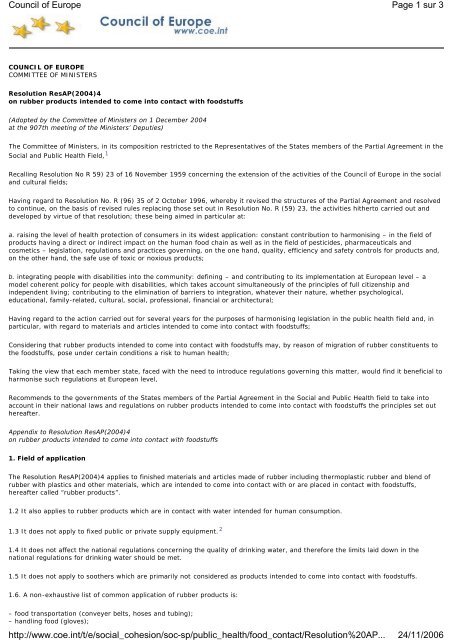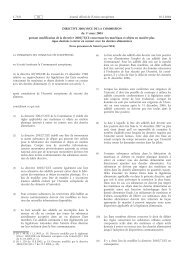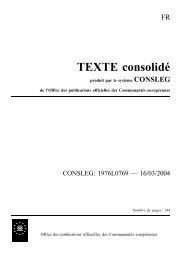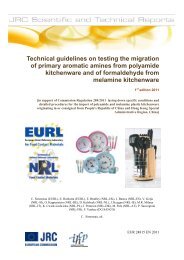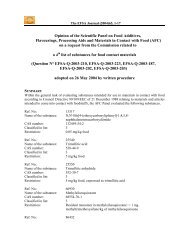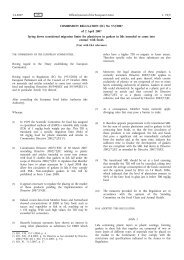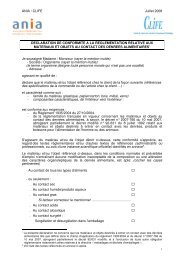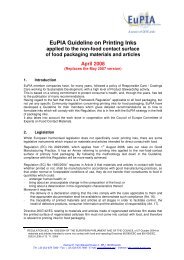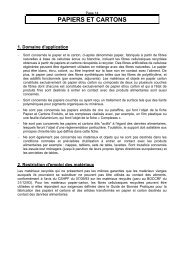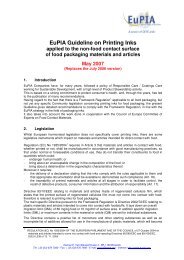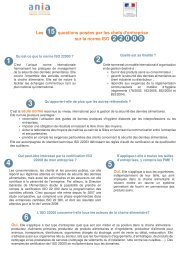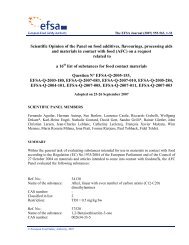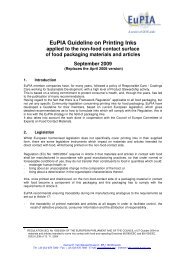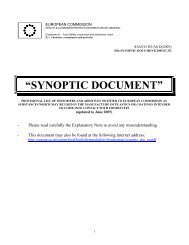Page 1 sur 3 Council of Europe 24/11/2006 http://www.coe.int/t/e ...
Page 1 sur 3 Council of Europe 24/11/2006 http://www.coe.int/t/e ...
Page 1 sur 3 Council of Europe 24/11/2006 http://www.coe.int/t/e ...
Create successful ePaper yourself
Turn your PDF publications into a flip-book with our unique Google optimized e-Paper software.
<strong>Council</strong> <strong>of</strong> <strong>Europe</strong><br />
<strong>Page</strong> 1 <strong>sur</strong> 3<br />
COUNCIL OF EUROPE<br />
COMMITTEE OF MINISTERS<br />
Resolution ResAP(2004)4<br />
on rubber products <strong>int</strong>ended to come <strong>int</strong>o contact with foodstuffs<br />
(Adopted by the Committee <strong>of</strong> Ministers on 1 December 2004<br />
at the 907th meeting <strong>of</strong> the Ministers’ Deputies)<br />
The Committee <strong>of</strong> Ministers, in its composition restricted to the Representatives <strong>of</strong> the States members <strong>of</strong> the Partial Agreement in the<br />
Social and Public Health Field, 1<br />
Recalling Resolution No R 59) 23 <strong>of</strong> 16 November 1959 concerning the extension <strong>of</strong> the activities <strong>of</strong> the <strong>Council</strong> <strong>of</strong> <strong>Europe</strong> in the social<br />
and cultural fields;<br />
Having regard to Resolution No. R (96) 35 <strong>of</strong> 2 October 1996, whereby it revised the structures <strong>of</strong> the Partial Agreement and resolved<br />
to continue, on the basis <strong>of</strong> revised rules replacing those set out in Resolution No. R (59) 23, the activities hitherto carried out and<br />
developed by virtue <strong>of</strong> that resolution; these being aimed in particular at:<br />
a. raising the level <strong>of</strong> health protection <strong>of</strong> consumers in its widest application: constant contribution to harmonising – in the field <strong>of</strong><br />
products having a direct or indirect impact on the human food chain as well as in the field <strong>of</strong> pesticides, pharmaceuticals and<br />
cosmetics – legislation, regulations and practices governing, on the one hand, quality, efficiency and safety controls for products and,<br />
on the other hand, the safe use <strong>of</strong> toxic or noxious products;<br />
b. <strong>int</strong>egrating people with disabilities <strong>int</strong>o the community: defining – and contributing to its implementation at <strong>Europe</strong>an level – a<br />
model coherent policy for people with disabilities, which takes account simultaneously <strong>of</strong> the principles <strong>of</strong> full citizenship and<br />
independent living; contributing to the elimination <strong>of</strong> barriers to <strong>int</strong>egration, whatever their nature, whether psychological,<br />
educational, family-related, cultural, social, pr<strong>of</strong>essional, financial or architectural;<br />
Having regard to the action carried out for several years for the purposes <strong>of</strong> harmonising legislation in the public health field and, in<br />
particular, with regard to materials and articles <strong>int</strong>ended to come <strong>int</strong>o contact with foodstuffs;<br />
Considering that rubber products <strong>int</strong>ended to come <strong>int</strong>o contact with foodstuffs may, by reason <strong>of</strong> migration <strong>of</strong> rubber constituents to<br />
the foodstuffs, pose under certain conditions a risk to human health;<br />
Taking the view that each member state, faced with the need to <strong>int</strong>roduce regulations governing this matter, would find it beneficial to<br />
harmonise such regulations at <strong>Europe</strong>an level,<br />
Recommends to the governments <strong>of</strong> the States members <strong>of</strong> the Partial Agreement in the Social and Public Health field to take <strong>int</strong>o<br />
account in their national laws and regulations on rubber products <strong>int</strong>ended to come <strong>int</strong>o contact with foodstuffs the principles set out<br />
hereafter.<br />
Appendix to Resolution ResAP(2004)4<br />
on rubber products <strong>int</strong>ended to come <strong>int</strong>o contact with foodstuffs<br />
1. Field <strong>of</strong> application<br />
The Resolution ResAP(2004)4 applies to finished materials and articles made <strong>of</strong> rubber including thermoplastic rubber and blend <strong>of</strong><br />
rubber with plastics and other materials, which are <strong>int</strong>ended to come <strong>int</strong>o contact with or are placed in contact with foodstuffs,<br />
hereafter called “rubber products”.<br />
1.2 It also applies to rubber products which are in contact with water <strong>int</strong>ended for human consumption.<br />
1.3 It does not apply to fixed public or private supply equipment. 2<br />
1.4 It does not affect the national regulations concerning the quality <strong>of</strong> drinking water, and therefore the limits laid down in the<br />
national regulations for drinking water should be met.<br />
1.5 It does not apply to soothers which are primarily not considered as products <strong>int</strong>ended to come <strong>int</strong>o contact with foodstuffs.<br />
1.6. A non-exhaustive list <strong>of</strong> common application <strong>of</strong> rubber products is:<br />
– food transportation (conveyer belts, hoses and tubing);<br />
– handling food (gloves);<br />
<strong>http</strong>://<strong>www</strong>.<strong>coe</strong>.<strong>int</strong>/t/e/social_cohesion/soc-sp/public_health/food_contact/Resolution%20AP...<br />
<strong>24</strong>/<strong>11</strong>/<strong>2006</strong>
<strong>Council</strong> <strong>of</strong> <strong>Europe</strong><br />
<strong>http</strong>://<strong>www</strong>.<strong>coe</strong>.<strong>int</strong>/t/e/social_cohesion/soc-sp/public_health/food_contact/Resolution%20AP...<br />
<strong>Page</strong> 2 <strong>sur</strong> 3<br />
<strong>24</strong>/<strong>11</strong>/<strong>2006</strong><br />
– food netting;<br />
– pipe-work components (seals, gaskets, flexible connectors and diaphragm/butterfly<br />
valves);<br />
– pumping systems (progressive cavity pumps stators, diaphragm pumps);<br />
– plate heat exchangers (gaskets);<br />
– general seals and gaskets (used in machinery and storage vessels);<br />
– can sealants;<br />
– bottle seals and clo<strong>sur</strong>es;<br />
– feeding teats and breast caps (nipple shields).<br />
2. Definitions<br />
Within the Resolution:<br />
2.1. rubber designates a family <strong>of</strong> materials having property <strong>of</strong> high elasticity. In an unaged state, rubber can be substantially<br />
deformed under stress, but recovers almost to its original stage when the stress is removed. Rubber is usually made from a mixture<br />
<strong>of</strong> (solid and/or liquid) materials and can be subjected to a curing process, which changes its nature;<br />
2.2. thermoplastic rubber is a polymer or blend <strong>of</strong> polymers that does not require vulcanisation or cross-linking during processing, yet<br />
has properties, at its service temperature, similar to those <strong>of</strong> vulcanised rubber. These properties disappear at processing<br />
temperature, so that further processing is possible, but return when the material is returned to its service temperature.<br />
3. Specifications<br />
Rubber products used for food contact applications should, under normal or foreseeable conditions <strong>of</strong> use, meet the following<br />
conditions:<br />
3.1. they should not transfer their constituents to foodstuffs in quantities which could endanger human health or bring about an<br />
unacceptable change in the composition <strong>of</strong> the foodstuffs or a deterioration in the organoleptic characteristics there<strong>of</strong>;<br />
3.2. they should be manufactured in accordance with the following requirements:<br />
3.2.1. they should comply with guidelines on good manufacturing practice for rubber products <strong>int</strong>ended to come <strong>int</strong>o contact with<br />
foodstuffs;<br />
3.2.2. they should be manufactured using the substances <strong>of</strong> “Technical document No. 1 – List <strong>of</strong> substances to be used in the<br />
manufacture <strong>of</strong> rubber products <strong>int</strong>ended to come <strong>int</strong>o contact with foodstuffs” and according to the conditions therein specified for<br />
each <strong>of</strong> the categories as set out in Article 5 <strong>of</strong> the Resolution. However, they can contain other decomposition and reaction products<br />
as well as impurities originating from authorised substances provided their migration complies with Article 3.1. <strong>of</strong> the Resolution;<br />
3.2.3. rubber products belonging to Categories I and II should not transfer their constituents to foodstuffs or<br />
food simulants in total quantities > 60mg/kg <strong>of</strong> food or food simulant (overall migration limit);<br />
3.2.4. rubber products <strong>of</strong> Categories I and II should comply with the restrictions laid down in “Technical<br />
document No. 1 - List <strong>of</strong> substances to be used in the manufacture <strong>of</strong> rubber products <strong>int</strong>ended to come <strong>int</strong>o contact with foodstuffs”.<br />
In addition these rubber products should comply with the requirements set out in Table 1 <strong>of</strong> the Resolution (see below), with the<br />
exception <strong>of</strong> rubber teats which should comply with Directive 93/<strong>11</strong>/EEC;<br />
Table 1: Restriction for N-nitrosamines, N-nitrosatable substances, aromatic amines<br />
Substance/substance group<br />
Restrictions<br />
– N-nitrosamines ND 1 (DL 2 = 0.01 mg/kg food or food stimulant)<br />
– N-nitrosatable substances ND (DL = 0.1 mg/kg food or food simulant)<br />
Aromatic amines<br />
ND unless an specific migration limit (SML) is set in<br />
Technical document N° 1<br />
1 ND = not detectable<br />
2 DL = the required detection limit <strong>of</strong> the analytical method at the indicated value<br />
3.3. substances should be used only in amounts strictly needed for the manufacturing and performance <strong>of</strong> the rubber product;<br />
3.4. where rubber is blended with plastics and/or other materials, the composition <strong>of</strong> these materials used in the blends should<br />
comply with relevant <strong>Council</strong> <strong>of</strong> <strong>Europe</strong> resolutions or <strong>Europe</strong>an Union directives, or, in their absence, with relevant national<br />
regulations. In addition, the rubber products should comply with the overall migration limit as well as with the relevant specific<br />
migration limits;<br />
3.5. rubber teats should also comply with Directive 93/<strong>11</strong>/EEC.<br />
4. Compliance testing
<strong>Council</strong> <strong>of</strong> <strong>Europe</strong><br />
<strong>http</strong>://<strong>www</strong>.<strong>coe</strong>.<strong>int</strong>/t/e/social_cohesion/soc-sp/public_health/food_contact/Resolution%20AP...<br />
<strong>Page</strong> 3 <strong>sur</strong> 3<br />
<strong>24</strong>/<strong>11</strong>/<strong>2006</strong><br />
4.1. Verification <strong>of</strong> compliance with the quantitative restrictions should be carried out according to the requirements laid down in<br />
“Technical document No. 2 - Practical guide for users <strong>of</strong> Resolution ResAP(2004) … on rubber products <strong>int</strong>ended to come <strong>int</strong>o contact<br />
with foodstuffs”;<br />
4.2. the verification <strong>of</strong> compliance with the specific migration limits provided for in Article 3.2. <strong>of</strong> the Resolution does not apply, if it<br />
can be established that compliance with the overall migration limit laid down in Article 3.2.3. <strong>of</strong> the Resolution implies that the specific<br />
migration limits are not exceeded;<br />
4.3. the verification <strong>of</strong> compliance with the specific migration limits provided for in Article 3.2. <strong>of</strong> the Resolution does not apply, if it<br />
can be established that, by assuming complete migration <strong>of</strong> the residual substance in the rubber product, it cannot exceed the specific<br />
limit <strong>of</strong> migration;<br />
4.4. the verification <strong>of</strong> compliance with the specific migration limits provided for in Article 3.2.3. <strong>of</strong> the Resolution may be en<strong>sur</strong>ed by<br />
the determination <strong>of</strong> the quantity <strong>of</strong> a substance in the finished rubber product provided that a relationship between that quantity and<br />
the value <strong>of</strong> the specific migration <strong>of</strong> the substance has been established either appropriate experiments or by the application <strong>of</strong><br />
generally recognised diffusion models based on scientific evidence. To demonstrate the non-compliance <strong>of</strong> a rubber product,<br />
confirmation <strong>of</strong> the estimated migration value by experimental testing is obligatory;<br />
4.5. rubber products <strong>int</strong>ended for repeated use should be subjected to tests according to Directive 2002/72/EC, Appendix I;<br />
4.6. the overall migration and specific limits per feeding teats are one-fifth <strong>of</strong> the values 3 set out in “Technical document No. 1 – List<br />
<strong>of</strong> substances to be used in the manufacture <strong>of</strong> rubber products <strong>int</strong>ended to come <strong>int</strong>o contact with foodstuffs”;<br />
4.7. rubber products belonging to Category III do not require migration testing, unless otherwise specified.<br />
5. Classification and migration requirements for rubber products<br />
Rubber products are classified in three categories: 4<br />
5.1. Category I comprising the following rubber products for which migration testing is required:<br />
– feeding teats;<br />
– rubber products <strong>int</strong>ended to come in contact with baby food, for which the R-total is equal to or greater than<br />
0.001;<br />
5.2. Category II, comprising other rubber products for which the R-total is equal to or greater than 0.001 and for which migration<br />
testing is required;<br />
5.3. Category III comprising rubber products for which the R-total is smaller than 0.001 and for which migration testing is not<br />
required, except for rubber products containing substances listed in Table 1 and Category III substances with an SML in “Technical<br />
document No. 1 – List <strong>of</strong> substances to be used in the manufacture <strong>of</strong> rubber products <strong>int</strong>ended to come <strong>int</strong>o contact with foodstuffs”.<br />
References:<br />
<strong>Council</strong> Directive <strong>of</strong> 21 December 1988 on the approximation <strong>of</strong> the laws <strong>of</strong> the member states relating to materials and articles<br />
<strong>int</strong>ended to come <strong>int</strong>o contact with foodstuffs (89/109/EEC) (Official Journal <strong>of</strong> the <strong>Europe</strong>an Communities L40, <strong>11</strong>.2.89).<br />
Commission Directive <strong>of</strong> 18 October 1982 laying down the basic rules necessary for testing migration <strong>of</strong> the constituents <strong>of</strong> plastic<br />
materials and articles <strong>int</strong>ended to come <strong>int</strong>o contact with foodstuffs (82/7<strong>11</strong>/EEC)<br />
(Official Journal <strong>of</strong> the <strong>Europe</strong>an Communities L297, 23.10.82).<br />
Commission Directive <strong>of</strong> 29 July 1997 amending for the second time <strong>Council</strong> Directive 82/7<strong>11</strong>/EEC laying down the basic rules<br />
necessary for testing migration <strong>of</strong> the constituents <strong>of</strong> plastic materials and articles <strong>int</strong>ended to come <strong>int</strong>o contact with foodstuffs<br />
(97/48/EC) (Official Journal <strong>of</strong> the <strong>Europe</strong>an Communities L222, 18.02.97).<br />
Commission Directive <strong>of</strong> 15 March 1993 concerning the release <strong>of</strong> N-nitrosamines and N-nitrosatable substances from elastomers or<br />
rubber teats and soothers 93/<strong>11</strong>/EEC) (Official Journal <strong>of</strong> the <strong>Europe</strong>an Communities L93, 17.04.93).<br />
Methods for determining the release <strong>of</strong> N-nitrosamines and N-nitrosatable substances from elastomers or rubber teats and soothers <strong>of</strong><br />
the <strong>Europe</strong>an Committee for Standardisation (CEN) (EN 12868, September 1999).<br />
<strong>Council</strong> <strong>of</strong> <strong>Europe</strong> Resolution AP (89) 1 on the use <strong>of</strong> colourants in plastic materials.<br />
<strong>Council</strong> <strong>of</strong> <strong>Europe</strong> Resolution AP (99) 3 on the use <strong>of</strong> silicones for food contact applications.


